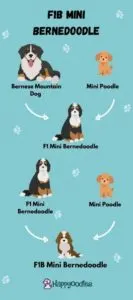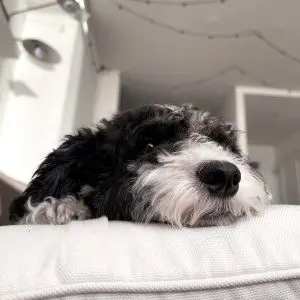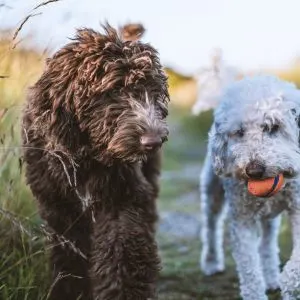Are you considering bringing a new furry friend into your life? If so, the F1B Bernedoodle might just be the breed you’ve been dreaming of! These charming crossbreeds are capturing the hearts of dog lovers worldwide.
In this comprehensive guide, we’ll cover everything you need to know about the F1B Bernadoodle, from their size and personality to their unique traits and shedding tendencies.
But why are so many people drawn to F1B Bernadoodle?
It’s simple – these dogs offer the perfect blend of looks, brains, and affection. As we dive deeper into this guide, you’ll discover why F1B Berniedoodles have become a sought-after choice for families and individuals alike.
So, whether you’re already smitten by the Bernadoodle or just beginning your journey to learn more about this wonderful breed, get ready to learn all about the F1B Bernedoodle.
Table of Content

What is a F1B Bernedoodle?
An F1B Berniedoodle is a mixed-breed dog that is generally bred by pairing a Poodle with an F1 Berniedoodle. F1B and F1 are both generation codes, used to inform buyers how the hybrid puppy was bred. Keep reading to learn more.
Understanding Bernedoodle Generation Codes
F1B is a doodle generation code that tells the potential dog buyer how the dog was bred. The “F” in F1B stands for “Filial”. This is a genetic term used to describe the generation or degree of hybridization in a breeding program. F1 means that this is the first generation of crossbreeds in this line.
The “b” refers to “backcross” This means a first generation Bernedoodle was mated to one of the original breeds. Either an unrelated Poodle or a Bernese Mountain dog can be used for the backcross.

When a poodle is used for the crossback, the F1B pairing results in offspring that is predominantly Poodle, with a genetic makeup of approximately 75% Poodle and 25% Bernese Mountain Dog.
F1B Bernedoodle Sizes
F1B Bernedoodles are bred in three size categories, that are carefully tailored to suit a wide range of preferences and living arrangements. Here’s an overview of each size range, including insights into their breeding:
1. Standard F1B Bernadoodle:
- Breeding Process: Standard F1B Bernedoodles are achieved by crossing a Standard Bernadoodle with a Standard Poodle. This combination results in puppies that inherit more of the Poodle’s genes creating a smaller dog compared to a F1 Bernedoodle.
- Height: These Bernedoodles typically stand between 23 to 29 inches at the shoulder.
- Weight: Their weight generally falls within the range of 60 to 100 pounds.

2. Mini F1B Bernadoodle:
- Breeding Process: Mini F1B Berniedoodles are created by pairing a Miniature Berniedoodle with a Mini Poodle. This breeding strategy results in offspring that inherit the mini Poodle’s genetics including their smaller size.
- Height: Mini F1B Berniedoodles are notably more compact, measuring between 18 to 22 inches at the shoulder, making them an excellent choice for those seeking a manageable-sized pet.
- Weight: Their weight typically ranges from 25 to 49 pounds.
3. Micro F1B Bernadoodle:
Breeding Process: Micro F1B Berniedoodles are achieved by crossing a mini Berniedoodle with a toy Poodle. This breeding approach focuses on size.
Height: Micro F1B Bernadoodles are the tiniest of the bunch, standing at just 12 to 17 inches at the shoulder, perfect for those with limited living space.
Weight: These diminutive dogs weigh only 10 to 24 pounds.
While these size ranges provide a general framework, individual F1B Berniedoodles may exhibit slight variations due to unique genetic factors and specific breeding practices. Prospective pet owners should work closely with reputable breeders to ensure they get the right sized pup that fits with their lifestyle and preferences.

F1B Temperament
The F1B Berniedoodle’s personality tends to lean towards the Poodle’s traits, displaying high intelligence, a quick learning ability, and an endearing goofiness that adds an element of playfulness to their character.
Yet, they also retain some of the Bernese Mountain Dog’s attributes, such as an affectionate and loyal nature, a laid-back demeanor, and, at times, a touch of stubbornness.
These dogs thrive on human interaction, forming strong bonds with their owners and wholeheartedly embracing their role as cherished family members. With proper socialization, they peacefully coexist with other pets and children
One thing worth noting is that Bernedoodles, irrespective of their generation, have a vocal side. This involves expressing themselves through an array of sounds that include barking, grumbling, whining, and various other vocalizations they’re capable of producing.
While they can be calm and content indoors, they do need a fair amount of exercise to deal with their bursts of energy. Regular exercise and mental stimulation are key to ensuring their happiness and overall well-being.
F1b Bernedoodle Appearance
The F1B Bernadoodle possess a distinctive and endearing appearance that often draws comparisons to a teddy bear. Their coat is typically curly or wavy, giving them a plush, soft, and fluffy appearance. Common coat colors include black, brown, and white, often featuring the tricolor pattern of the Bernese Mountain Dog. They can also come in solid colors and two toned.
Their facial features are expressive, with warm and soulful eyes, often accompanied by floppy or semi-erect ears and a well-proportioned muzzle, often adorned with a black nose. Their physique is sturdy and well-muscled, reflecting their working dog heritage.
Can’t decide between the Bernedoodle and the Bernese Mountain Dog? Check out our post Bernedoodle vs Bernese Mountain Dog: 12 Key Differences

F1b Bernedoodle Colors
Bernedoodles can come in a variety of colors and patterns, influenced by both their Bernese Mountain Dog and Poodle genetics. Here are some of the common colors and patterns you may find in Bernedoodles:
Colors of the Bernese Mountain Dog:
- Tricolor: Tricolor Bernedoodles typically feature a tricolor pattern with black, rust or tan, and white markings.
Colors of the Poodle:
- Apricot
- Cream
- Black
- Black and white – this is a common Bernedoodle color combination
- Sable – this can include shades of brown and may be paired with white markings.
- Sable and white
- Phantom – Phantom Bernedoodles have a specific pattern with markings on the eyebrows, muzzle, throat, chest, legs, and paws in a contrasting color to the main body color.
It’s important to note that the specific color and pattern of a Bernedoodle can vary widely, even within the same litter. Breeders may aim to produce Bernedoodles with desired colors and patterns, but the outcome can still be somewhat unpredictable.
F1B Bernedoodle Lifespan
The lifespan of an F1B Bernadoodle is influenced by the life expectancy of its parent breeds. Poodles tend to have a longer lifespan, often reaching 12 to 15 years, due to their genetic predisposition to fewer health issues. On the other hand, Bernese Mountain Dogs typically have a shorter lifespan, around 7 to 10 years, often due to breed-specific health challenges like cancer.
On average, F1B Bernadoodles tend to have a lifespan of approximately 12 to 16 years.
The exact lifespan of an F1B Bernadoodle will vary based on factors like genetics, diet, exercise, preventive care, and living conditions. Responsible ownership and proactive health management also play a crucial role in enhancing their longevity.
Why Choose a F1b Bernedoodle over an F1
People often prefer the F1B Bernedoodle over the F1 Bernedoodle for several reasons. First, the F1B Bernedoodle has a higher likelihood of having a non-shedding coat due to its increased Poodle genetics. This feature may make them a more suitable choice for individuals with pet dander allergies.
Second, the F1B Bernedoodle often has a curlier coat, which some people prefer though they are harder to maintain.
Third, their temperament is usually more consistent and predictable, as they have a higher percentage of Poodle genes. Poodles are known for their friendly and trainable nature.

F1b Bernedoodle Care
Exercise Requirements
The F1B Bernadoodle is an active dog that typically requires a moderate amount of daily exercise to stay healthy and happy. On average, they should get around 30 to 60 minutes of exercise, two to three times a day. This exercise can include activities like brisk walks, playtime in a fenced yard, interactive games, and mental stimulation through puzzle toys or training sessions.
It’s important to note that individual exercise needs can vary based on factors such as age, size, and temperament. Some F1B Bernedoodles may have higher energy levels and require more exercise, while others may be content with a bit less.
Paying attention to your dog’s cues and adjusting their exercise routine accordingly can help ensure they get the right amount of physical activity to keep them fit and mentally stimulated.
Coat Maintenance
The F1B Bernedoodle’s coat is generally curly or wavy, requiring more maintenance than a Bernese Mountain Dog. While they are typically low-shedding, they require regular grooming to prevent matting and maintain the coat’s health and appearance.
Regular grooming includes brushing and combing their fur every few days and taking them for professional grooming every 4-8 weeks.
Possible Health Conditions
F1B Bernedoodles, like all dog breeds, can be susceptible to certain health conditions. Common health conditions that can impact the F1B include:
- Hip Dysplasia: This condition involves abnormal hip joint development, which can lead to pain and arthritis. It is common in many dog breeds, including Bernese Mountain Dogs.
- Elbow Dysplasia: Elbow dysplasia is a similar joint condition affecting the front legs and can cause lameness and discomfort.
- Progressive Retinal Atrophy (PRA): PRA is a group of inherited eye diseases that can lead to blindness.
- Gastric Torsion (Bloat): Larger dogs like the Bernese Mountain Dog and poodle can be prone to bloat, which is a life-threatening condition where the stomach twists and traps gas and food.
- Heart Conditions: Some heart conditions, such as mitral valve disease, can affect Bernese Mountain Dogs and may be inherited by the Bernedoodle.
- Cancer: Cancer is a concern in Bernese Mountain Dogs and can also affect Bernedoodles.
- Skin Allergies: Skin allergies, including environmental and food allergies, can cause skin irritation, itching, and discomfort.
- Ear Infections: Due to their floppy ears, Bernedoodles can be prone to ear infections, especially if their ears are not properly cleaned and dried.
- Autoimmune Disorders: Some autoimmune disorders can affect the immune system and lead to various health issues.
- Hypothyroidism: A deficiency in thyroid hormones can cause metabolic and energy regulation problems.
Please note this may not be a complete list of health concerns for the Bernedoodle, nor are we veterinarians. This should not be taken as medical advice and may not be accurate. Please seek professional help if you have any questions.

Frequently Asked Questions
1. Do F1b Bernedoodle Shed?
F1B Bernedoodles typically have minimal shedding, thanks to their increased Poodle genetics. However, no dog is non-shedding. It’s important to remember that individual dogs may exhibit some degree of shedding, and the exact amount can vary. Regular grooming and coat maintenance can help keep shedding to a minimum.
2. When do F1b Bernedoodles settle down?
Due to their energetic and playful nature it may seem like your Bernedoodle will never settle down, but rest assured that they will, eventually. As large sized dogs, a standard sized F1b Berniedoodle will continue to grow and mature until around 2 years old. This is when most Bernedoodle owners state that their dog calmed down.
3. Are F1b Berniedoodles Hypoallergenic
Most people with pet allergies react to a protein found in a dog’s dander, saliva, urine, and feces. Poodles have genes that lead to less shedding, and since the F1B Berniedoodle has a significant Poodle influence, they are often seen as hypoallergenic.
While no dog can be completely hypoallergenic, the lower shedding and reduced distribution of allergenic substances make F1B Bernedoodles a potentially better choice for individuals with pet allergies compared to breeds with heavier shedding coats.
However, the degree of hypoallergenicity can vary among individual dogs, and it’s essential for allergy-sensitive individuals to spend time with a specific dog to determine their tolerance before bringing one into their home.
4. When should you start grooming your Bernedoodle puppy?
You should start brushing your puppy as soon as you bring them home. It is important for them to become accustomed to frequent grooming, since they will need it for the rest of their lives. Talk to your veterinarian about when it is safe to bring them to the groomer.
Once you get the approval from your veterinarian, bring your puppy to the groomer for a puppy cut. This usually includes a sanitary cut and bath.
5. How much does a F1B Bernedoodle Cost?
The cost of an F1B Bernadoodle can vary significantly based on various factors, including the breeder’s reputation, the location, the lineage of the parents, and the puppy’s specific traits and characteristics. On average, you can expect to pay between $2,000 to $5,000, with the popular tri-color pups being the most expensive.
6. Where to find a Bernedoodle?
When searching for a Bernedoodle you can either look for a Bernedoodle rescue or go to a quality breeder. If you choose to get your pup from a breeder make sure to ask a lot of questions.
The breeder should be knowledgeable of the Bernedoodle puppies, parent breeds and the breeding process. It is best not to buy from a middleman, like a puppy store or online puppy for sale site. Plus, they should be able to provide proof of the health testing for unwanted genetic traits on parent dogs.
7. How long does it take to get a Bernedoodle from a Breeder?
It’s common to have to wait 6 to 12 months for a puppy from a quality breeder. If you want a Bernadoodle with tri-color markings the wait can be even longer.
8. Are Bernedoodles good with children and other pets?
F1B Bernedoodles are generally known for being good with children and other pets when they are properly socialized and raised in a loving and positive environment. It is equally important to teach your children how to behave around a dog.
Want to learn more about the Bernedoodle? Check out our post on 17 Things You May Not Know About The mini Bernedoodle.
Bringing Home a Bernedoodle
Once you decide you want a Bernedoodle, you should start thinking about what you need for when you bring your puppy home. Puppies require many things, like a leash and collar, food bowls and toys.
One of the things you might not think about is where your puppy will go to the bathroom. Having an established place to train your puppy to go outside will make potty training easier. To learn more, check out our posts on Potty Training a Puppy: Made Easy and Outdoor Dog Potty Area Guide.
For naming ideas check out our post on 775+ Bernedoodle Dog Names: The Ultimate
